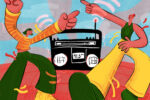While many of the most popular music genres, such as rock & roll, jazz, hip-hop and funk, have their roots in African American culture, one genre that grew from the Black community and has experienced seemingly everlasting popularity is house music. Though different subgenres grew (and sometimes fizzled out) over the years, house music’s basic components have guaranteed its success both in clubs and on the radio for decades. This is the story of house music.
House is a genre of electronic dance music that originated in the early 1980s in Chicago, Illinois. It is characterized by its repetitive 4/4 beat, synthesized melodies and use of electronic instruments such as drum machines, synthesizers and samplers. The term “house music” is said to have originated from the Warehouse, a nightclub in Chicago where resident DJ Frankie Knuckles popularized the genre. Knuckles, a Black gay man with a great love of disco, referred to house music as “disco’s revenge.”
In the 1970s, disco was by far the most popular genre of music in America. Rooted in the funk and soul of the 1960s, it was most popular with Black, Latino and queer clubgoers. Because those people were all members of marginalized groups, disco’s popularity spelled, to the conservative white rock fan, the end of straight white male dominance in American culture. After Disco Demolition Night, where white heterosexual male rock fans destroyed disco records at the Chicago White Sox stadium, disco, and by extension dance music in general, went from being mainstream to only heard in underground clubs. These clubs attracted Black, Latino and queer people from all over the Windy City, and their DJs combined disco with drum machines and techniques inspired by synthpop artists such as Kraftwerk of Germany, Giorgio Moroder of Italy and Yellow Magic Orchestra of Japan, whose work gained popularity in the 1970s and 1980s.
House music emerged in the aftermath of disco as DJs and producers sought to create a new sound that was more stripped-down and minimalistic. Early house tracks were often instrumental with sparse arrangements and repetitive hooks. The drum machine was a key component of early house music, providing the driving 4/4 beat that is still a hallmark of the genre.
One of the earliest and most influential house tracks, released in 1984, was “On and On” by Jesse Saunders. The track was a hit in Chicago, and helped to establish the genre. Other early house music pioneers include Frankie Knuckles, Marshall Jefferson and Larry Heard, who produced under the moniker Mr. Fingers.
House music quickly spread beyond Chicago, first to other cities in the United States, and then to Europe. In the UK, the genre was embraced by the acid house and rave scenes and became a major cultural force. The rise of house music coincided with the spread of club culture as dance clubs and all-night raves became popular venues where young people could socialize and dance.
One of the defining characteristics of house music is its emphasis on the DJ as a creative force. House DJs often blend tracks together seamlessly, using beatmatching and other techniques to create a continuous flow of music. This approach to DJing has been hugely influential, and has helped shape the way that DJs approach their craft today.
As house music continued to evolve, it incorporated elements of other genres such as funk, soul and disco. The use of samples and loops became more prevalent as producers experimented with different sounds and textures. In the late 1980s and early 1990s, house music began to fragment into sub-genres, including deep house, acid house, and techno.
Deep house, characterized by its soulful vocals and jazzy instrumentation, emerged as a response to the more aggressive and electronic sounds of acid house and techno. The genre was pioneered by producers such as Larry Heard, Frankie Knuckles and Kerri Chandler, and it remains popular today.
Acid house, named after the distinctive “acid” sound of the Roland TB-303 synthesizer, is a more abrasive and psychedelic form of house music. Acid house tracks often feature squelchy basslines and distorted samples. The genre was closely associated with the rave culture of the late 1980s and early 1990s.
Techno originated in Detroit in the early 1980s and was originally a more stripped-down and mechanical form of electronic music. Techno tracks often featured complex rhythms and futuristic soundscapes, and the genre was hugely influential in the development of electronic dance music.
House music continued to evolve throughout the 1990s and 2000s as producers continued to experiment with new sounds and technologies. The rise of digital music production and distribution made production and release easier for independent artists, and the internet provided a global platform for the promotion and dissemination of new music.
Today, house music remains a vital and vibrant genre with a thriving global community of producers, DJs and fans. The sound of house music continues to evolve and mutate as artists draw on a diverse range of influences and styles. Whether in the club or in the studio, house music continues to inspire and excite, but we must not forget the roots of this genre: marginalized groups of people pushing back against discrimination with the power of music.
















